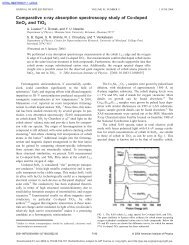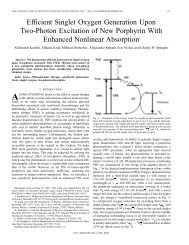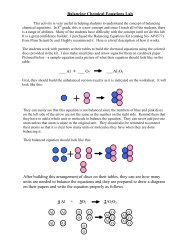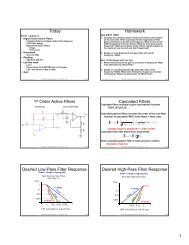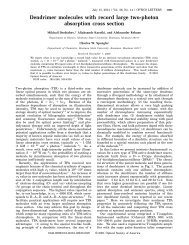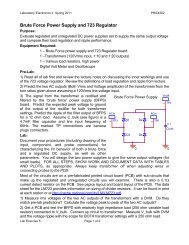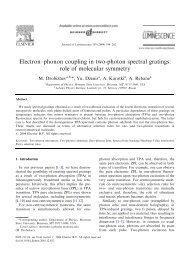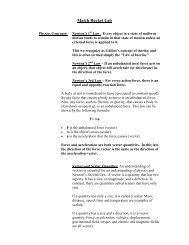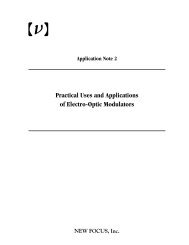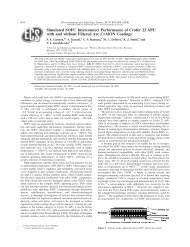Defects in inorganic photorefractive materials and their investigations
Defects in inorganic photorefractive materials and their investigations
Defects in inorganic photorefractive materials and their investigations
Create successful ePaper yourself
Turn your PDF publications into a flip-book with our unique Google optimized e-Paper software.
2 B. Briat et al.<br />
with its extensions, are unsurpassed <strong>in</strong> furnish<strong>in</strong>g such <strong>in</strong>formation, <strong>and</strong> methods<br />
have been developed to transfer this knowledge to the optical absorption<br />
phenomena. They will be outl<strong>in</strong>ed below. Detailed knowledge on defects <strong>in</strong><br />
<strong>photorefractive</strong> <strong>materials</strong> <strong>and</strong> the reliable <strong>in</strong>terpretation of <strong>their</strong> absorption<br />
b<strong>and</strong>s thus rests almost exclusively on EPR <strong>and</strong> EPR-related <strong>in</strong>vestigations.<br />
The Mössbauer effect may be cited as an exception; unfortunately it is essentially<br />
restricted to iron conta<strong>in</strong><strong>in</strong>g defects. Therefore the Chapter ma<strong>in</strong>ly<br />
rests on <strong>in</strong>vestigations by EPR <strong>and</strong> related methods.<br />
In ideal situations, studies of defects furnish knowledge of <strong>their</strong> structure,<br />
<strong>in</strong>clud<strong>in</strong>g the chemical identity, geometry <strong>and</strong> charge state, of the <strong>in</strong>corporation<br />
site <strong>in</strong> the lattice, the nature of the electronic ground <strong>and</strong> excited states<br />
<strong>and</strong> <strong>their</strong> energies, the optical <strong>and</strong> thermal excitation mechanisms, the light<strong>in</strong>duced<br />
transfer of charges to the valence <strong>and</strong> conduction b<strong>and</strong>s <strong>and</strong>, on this<br />
basis, the prediction of the <strong>photorefractive</strong> performance of a material. In some<br />
cases these aims could be achieved rather closely, generally, however, many<br />
questions rema<strong>in</strong> unanswered <strong>and</strong> offer opportunities for further research.<br />
Several chapters <strong>in</strong> the two volumes on <strong>photorefractive</strong> <strong>materials</strong> edited<br />
by Günter <strong>and</strong> Huignard <strong>in</strong> 1988 [1] conta<strong>in</strong> <strong>in</strong>formation on defects <strong>in</strong> such<br />
compounds. S<strong>in</strong>ce then new methods for defect <strong>in</strong>vestigation have been developed<br />
<strong>and</strong> the range of results obta<strong>in</strong>ed <strong>in</strong> the field has vastly exp<strong>and</strong>ed. This<br />
Chapter will give a survey of the present status of the studies. It starts with<br />
a brief general overview on the properties of defects <strong>and</strong> <strong>their</strong> classification;<br />
then an <strong>in</strong>troduction to the experimental methods employed will follow. The<br />
later sections will deal with the defect related results obta<strong>in</strong>ed for the various<br />
classes of <strong>photorefractive</strong> <strong>in</strong>organic <strong>materials</strong>. Also a short section cover<strong>in</strong>g the<br />
properties of hydrogen <strong>in</strong> oxide <strong>materials</strong> is <strong>in</strong>cluded. The brevity necessary<br />
for cover<strong>in</strong>g a large field of research <strong>in</strong> a short chapter will be compensated<br />
by giv<strong>in</strong>g an extended list of references. For a recent review on defects <strong>in</strong> <strong>in</strong>organic<br />
<strong>photorefractive</strong> <strong>materials</strong> with an emphasis on applications, an article<br />
by Buse [2] can be consulted.<br />
2 Classification <strong>and</strong> general properties of defects<br />
A defect is anyth<strong>in</strong>g which perturbs the translational symmetry of a crystal.<br />
In this Chapter the term defect will be used <strong>in</strong> a narrower sense: only po<strong>in</strong>t like<br />
perturbations will be treated, i.e. cases where an ion of the lattice is miss<strong>in</strong>g<br />
or lattice sites are replaced by nonregular ions. Also, small clusters of such<br />
po<strong>in</strong>t defects may be <strong>in</strong>cluded. If only ions are <strong>in</strong>volved which belong to the<br />
ideal crystal, the defects are <strong>in</strong>tr<strong>in</strong>sic, otherwise they are extr<strong>in</strong>sic. Examples<br />
for <strong>in</strong>tr<strong>in</strong>sic defects are vacancies or antisite defects. A Bi ion replac<strong>in</strong>g Si<br />
<strong>in</strong> the sillenite Bi 12 SiO 20 , labelled Bi Si , is an example of the latter. In this<br />
article we mostly use this type of labell<strong>in</strong>g; the chemical symbol for the ion<br />
present is appended by a subscript, mark<strong>in</strong>g the site of replacement. The<br />
letter ’V’ is used <strong>in</strong> this context as a symbol for vacancy; e.g. ’V O ’ st<strong>and</strong>s for





